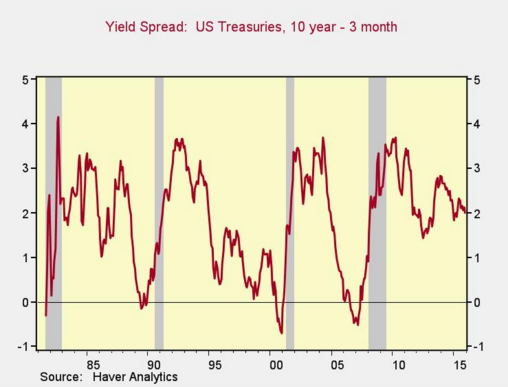Despite a short-term pullback from close to a record high, we remain in healthy territory, consistent with the 1990s and 2000s. It would take a significant pullback to land us in the trouble area. Although this could happen quickly, past results have been slower. Coupled with the delay before a recession actually starts, this means we’re likely looking at 12 months or so, at the soonest, and probably longer before an actual recession.
4. Yield Curve
The last piece of the puzzle is what’s known as the yield curve, which measures the difference between longer-term interest rates and shorter-term ones. If longer rates are lower than shorter rates, this “inverts” the yield curve—a bad sign. Here’s an easier way to look at it: simply subtract the shorter rates (in this case, the 3-month Treasury rate) from the longer-term rates (in this case, the 10-year Treasury rate), as in the following chart:

You can see that when the spread between long- and short-term rates drops to zero or below, a recession follows in a couple of quarters. Once again, though, this indicator remains at healthy levels. Even with the recent Fed rate increases, the spread is nowhere close to the worry zone.
A Recession Is Coming—One Of These Days
Any one of these indicators could be wrong, of course, and the fundamentals behind any of them can be argued. Perhaps employment is worse than it seems, or perhaps the Fed’s policy makes the yield spread misleading. In aggregate, however, they represent a broad spectrum of the economy and the drivers of growth. When all of the indicators are positive, as they are now, it suggests that the economy is fundamentally healthy—and any recession is some time away.
You might also note that these metrics cover a number of economic cycles, with different economic fundamentals and shocks in each. Again, you could argue with the indicators for any particular cycle. But, overall, the results are consistent.
There is certainly a recession coming someday, but I don’t think it will be soon. And when one does get close, I suspect decay in these key indicators will provide ample warning.
Brad McMillan is the chief investment officer at Commonwealth Financial Network, the nation’s largest privately held independent broker/dealer-RIA.
Brad McMillan is the chief investment officer at Commonwealth Financial Network, the nation’s largest privately held independent broker/dealer-RIA.








